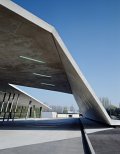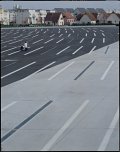Zaha Hadid: Terminus Hoenheim-Nord Strasbourg
BACKGROUND
The city of Strasbourg has been developing a new tram-line service to combat
increasing congestion and pollution in the city centre. It encourages people to
leave their cars outside the city in specially designed car parks, and then
take a tram to the more inner parts of the city. The first part of this
initiative was the development of Line 'A' that ran east to west across
Strasbourg. A parallel initiative to the design of the transport system was the
inclusion of a number of artists, such as Barbara Kruger and Mario Mertz, to
make specific installations at key points of the line. Currently, Strasbourg is
planning the second line, 'B', that will run north to south. Zaha Hadid has
been invited, as part of the new artist's interventions, to design the
tram-station and a car park for 700 cars at the northern apex of the line.

CONCEPT
The overall concept towards the planning of the car park and the station is one
of overlapping fields and lines that knit together to form a constantly
shifting whole. Those 'fields' are the patterns of movement engendered by cars,
trams, bicycles and pedestrians. Each has a trajectory and a trace, as well as
a static fixture. It is as though the transition between transport types (car
to tram, train to tram) is rendered as the material and spatial transitions of
the station, the landscaping and the context.
MATERIALISED VECTORS
The Station contains a basic program of waiting space, bicycle storage, toilets
and shop. This sense of three dimensional vectors is enhanced in the treatment
of space: the play of lines continues as light lines in the floor, or furniture
pieces or strip-lights in the ceiling. Viewed in plan, all the 'lines' coalesce
to create a synchronous whole. The idea is to create an energetic and
attractive space that is clearly defined in terms of function and circulation,
which is made possible through three-dimensional graphics of light and
openings.

MAGNETIC FIELDS
The car park is divided into two parts to cater for 700 cars. The notion of
the cars as being ephemeral and constantly changing elements on site is
manifest as a 'magnetic field' of white lines on the black tarmac. These
delineate each parking space and start off aligned north/south at the lowest
part of the site, then gently rotate according to the curvature of the site
boundaries. Each space has a vertical light post. In contrast with the lines on
the ground, an area of darker concrete, almost an imaginary 'shadow', cuts
gently through the car park, linking the field of the station to the one of the
car park. Overall, the 'field' of the light posts maintains a constant datum
height that combines with the gradient of the floor slope. Again, the intention
is to reciprocate between static and dynamic elements at all scales.
As an ensemble, the Tram station and the car park create a synthesis between
floor, light and space. By articulating the moments of transition between open
landscape space and public interior space, it is hoped that a new notion of an
'artificial nature' is offered, one that blurs the boundaries between natural
and the artificial environments towards the improving of civic life for
Strasbourg.